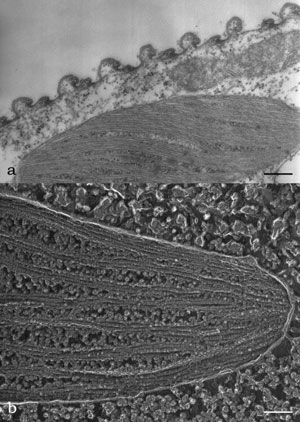Euglenophyta
As in the Dinophyta the chloroplast envelope consists of three membranes. Chloroplasts are typically many per cell and show considerable diversity of size, shape, and morphology (Figure 2.80a and 2.80b).
Five main types can be recognized:

FIGURE 2.80 Transmission electron microscopy image of a chloroplast of Euglena gracilis in longitudinal section (a) (Bar: 0.10 µm). Deep-etching image of a chloroplast of E. gracilis (b) (Bar: 0.05 µm).
- Discoid chloroplasts with no pyrenoids (Phacus)
- Elongated or shield shaped chloroplasts with a central naked pyrenoid (Trachelomonas)
- Large plated chloroplasts with the so-called double sheeted pyrenoid, that is, a pyrenoid which carries on both plastid surfaces a watch glass shaped cup of paramylon (Euglena obtusa)
- Plate chloroplasts having a large pyrenoid projecting from the inner surface, which is covered by a cylindrical or spherical cup of paramylon (Colacium)
- Chloroplast ribbons radiating from one or three paramylon centers (Eutreptia)

FIGURE 2.80 Transmission electron microscopy image of a chloroplast of Euglena gracilis in longitudinal section (a) (Bar: 0.10 µm). Deep-etching image of a chloroplast of E. gracilis (b) (Bar: 0.05 µm).
The chloroplasts are never connected to the nucleus by the endoplasmic reticulum, and thylakoids are usually grouped into threes forming lamellae as in Heterokontophyta and Dynophyta. Girdle lamellae are never found in this group. The photosynthetic pigments are chlorophylls a and b with carotenes and xanthophylls as accessory pigments. Chloroplast DNA occurs as tiny granules throughout the whole stroma.




